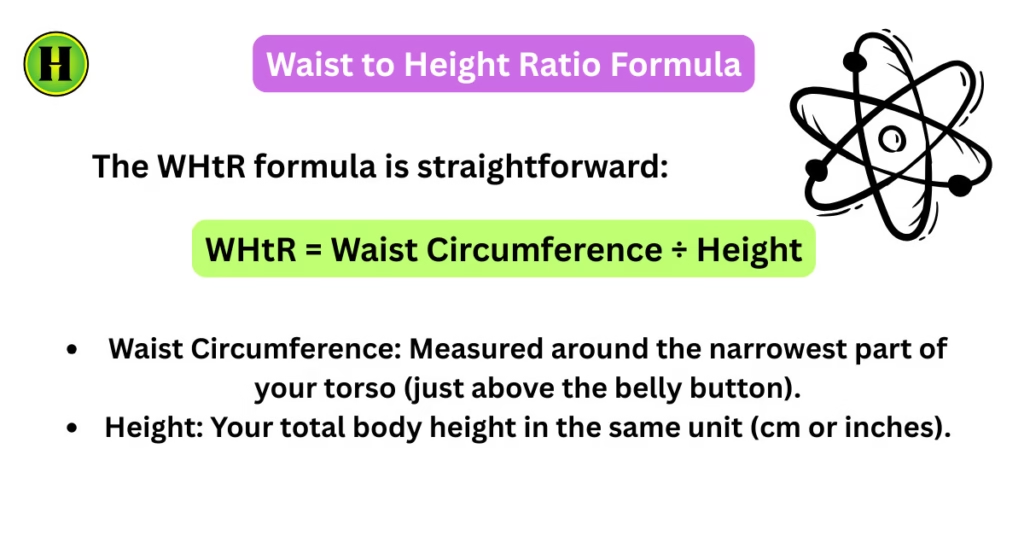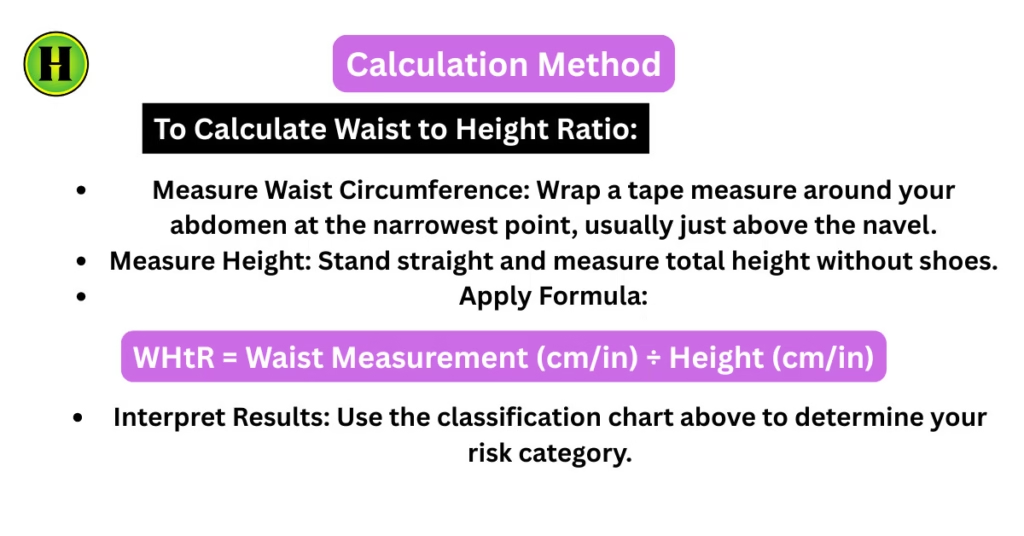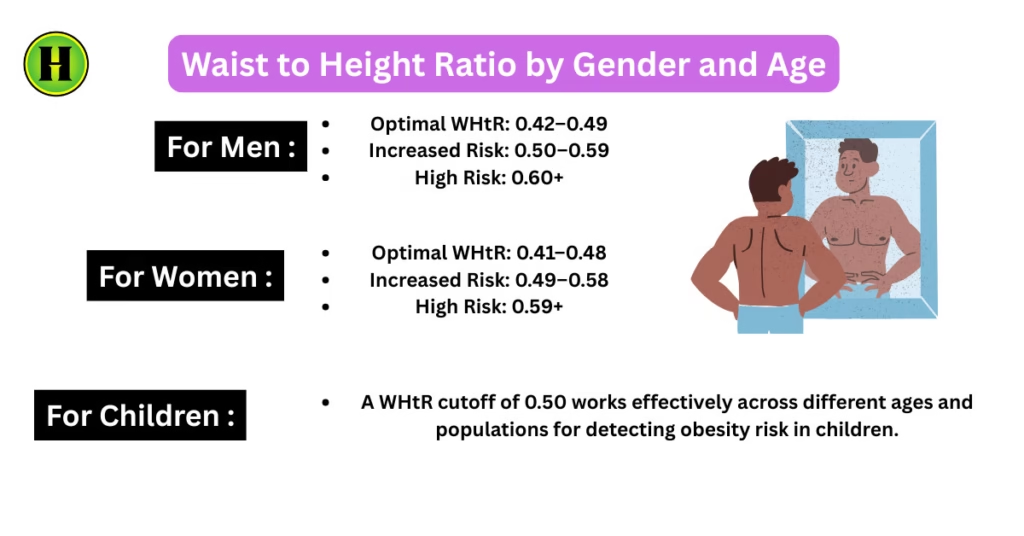Waist to Height Ratio Calculator.

Related Body Measurement Calculators
- A Body Shape Index (ABSI) Calculator
- Adjusted Body Weight Calculator
- Body Adiposity Index-BAI Calculator
- Body Fat Calculator
- Body Frame Size Calculator
- Body Shape Calculator
- Body Roundness Index-BRI Calculator
- Body Surface Area-BSA Calculator
- Bedridden Patient Height Calculator
- Face Shape Calculator
- FFMI Calculator (Fat-Free Mass Index)
- Ideal Weight Calculator
- Karvonen Formula Calculator
- Lean Body Mass Calculator
- Overweight Calculator
- Ponderal Index Calculator
- RFM Calculator (Relative Fat Mass)
- Skinfold Body Fat Calculator
- Waist to Hip Ratio Calculator
- Weight Loss Percentage Calculator
Maintaining a healthy body is very important for a human being, so not only weight factor matters . Traditional metrics like BMI (Body Mass Index) may not show you complete information about where fat is stored in the body , so here comes waist to height ratio calculator, which provides you with complete fat distribution results and helps you control your obesity related problems which may lead to hgealth risks like Cardiovascular complications, heart strokes, metabolism, type 2 diabetes, and premature mortality. etc….
In this article let’s know about waist to height ratio, its formula, classification chart, How to improve and how you can use the Healthmole Waist to Height Ratio Calculator to assess and improve your health and more….
What is Waist to Height Ratio (WHtR)?
Waist to Height Ratio (WHtR) is the best measurement which compares waist circumference to your height. It provides clear distribution of fat in our body and you can easily detect the upcoming health risks and be alert.
The principle is simple:
- Your waist must be less than half your height which may help in minimizing health risks.
- Example: If your height is 160 cm, your waist should be below 75 cm.
Waist to Height Ratio Formula

WHtR Classification Chart
| Waist to Height Ratio Value | Health Risk Category |
|---|---|
| < 0.40 | Underweight (possible malnutrition) |
| 0.40–0.49 | Healthy (low risk) |
| 0.50–0.59 | Overweight (increased risk) |
| 0.60+ | Obese (high risk of cardiovascular and metabolic disease) |
Why Waist to Height Ratio is More Accurate Than BMI
BMI Limitations:
- BMI does not differentiate between Fat and Muscle.
- Body Mass Index cannot show you fat distribution
- Misclassifies muscular or athletic individuals.
Advantages of Waist to Height Ratio:
- Focuses on abdominal fat (the most dangerous type).
- Works across all ages, genders, and ethnicities.
- Strong predictor of diabetes, hypertension, and heart disease.
- Easier to interpret with one simple rule: “Keep your waist under half your height.”
Calculation Method

Waist to Height Ratio by Gender and Age

Waist to Height Ratio vs Other Health Indicators
| Indicator | Measures | Pros | Cons |
|---|---|---|---|
| BMI | Weight vs Height | Quick & universal | Doesn’t show fat distribution |
| WHR (Waist to-Hip Ratio) | Waist vs Hips | Identifies body shape patterns | Less predictive than Waist to Height Ratio |
| WHtR (Waist to Height Ratio) | Waist vs Height | Strongest predictor of central obesity | Needs accurate waist measurement |
| Body Fat Percentage | Direct fat content | Most accurate overall | Requires special tools (DEXA, calipers) |
Health Risks of High Waist to Height Ratio
There are a lot many health risks associated with a high waist to height ratio :
- Central obesity may become the biggest risk factor for cardiovascular problems.
- Visceral fat will disrupt insulin regulation which may lead to type 2 diabetes.
- Belly fat increases blood pressure, which will lead to Hypertension.
- Abdominal fat causes Heart strokes.
- A combination of high blood sugar, hypertension, and obesity will lead to Metabolic Syndrome.
How to Improve Your WHtR
When you observe a high waist to height ratio, then you must work out on the waist reduction strategies rather than weight alone.
- Exercise regularly and try to engage in regular cardiovascular activities such as swimming, cycling, running, and brisk walking. Also, don’t forget to practice strength training.
- Take a Healthy diet like lean proteins, Whole grains, vegetables, and fruits for fiber. Don’t forget to reduce your intake of sugar, fried foods, and snacks.
- Do Lifestyle Modifications like 7–9 hours of daily sleep, Practice stress management like meditation and yoga, and limit alcohol intake levels.
Medical Disclaimer
This tool is made for educational and informational purposes only. I suggest you please always consult a licensed healthcare professional for medical advice.
Why to Prefer Healthmole’s Calculator ?
- It is 100% Free and Easy to use to find the Body Proportion Index.
- The calculator tools are based on up-to-date National medical guidelines.
- Every mobile supports the tool.
- No data stored or shared to anybody and your data is completely erased on reset button.
- It supports both metric and imperial units to get your output.
FAQs
Yes. WHtR is a stronger predictor of obesity-related health risks.
Keep your waist size less than half your height.
Yes. A simple measuring tape is all you need.
Yes. A WHtR ≥0.50 is a good cutoff for obesity in children.
Yes. Cardio and strength training help lower abdominal fat.
Slightly, but the general rule (<0.50) works worldwide.
Yes. Studies confirm WHtR is strongly linked to diabetes risk.
It works well across all ages, unlike BMI.
Every 2–3 months is recommended for tracking.
WHtR is generally considered superior for predicting health risks.
Final Thoughts
At Healthmole, our free waist to height ratio Calculator makes it easy to know your risk and take advanced action. Remember the golden rule: “Keep your waist under half your height.” Doing so can easily reduce your risk of heart disease, diabetes, stroke, and premature death, etc….
References
- Waist-to-height ratio as a screening tool for obesity and diabetes risk
- Waist-to-height ratio as an indicator of ‘early health risk.
- Performance of waist-to-height ratio as a screening tool for cardiometabolic risk in children & adolescents
- At risk’ waist-to-height ratio cut-off points recently adopted
- Distribution of waist-to-height ratio and cardiometabolic risk in a population